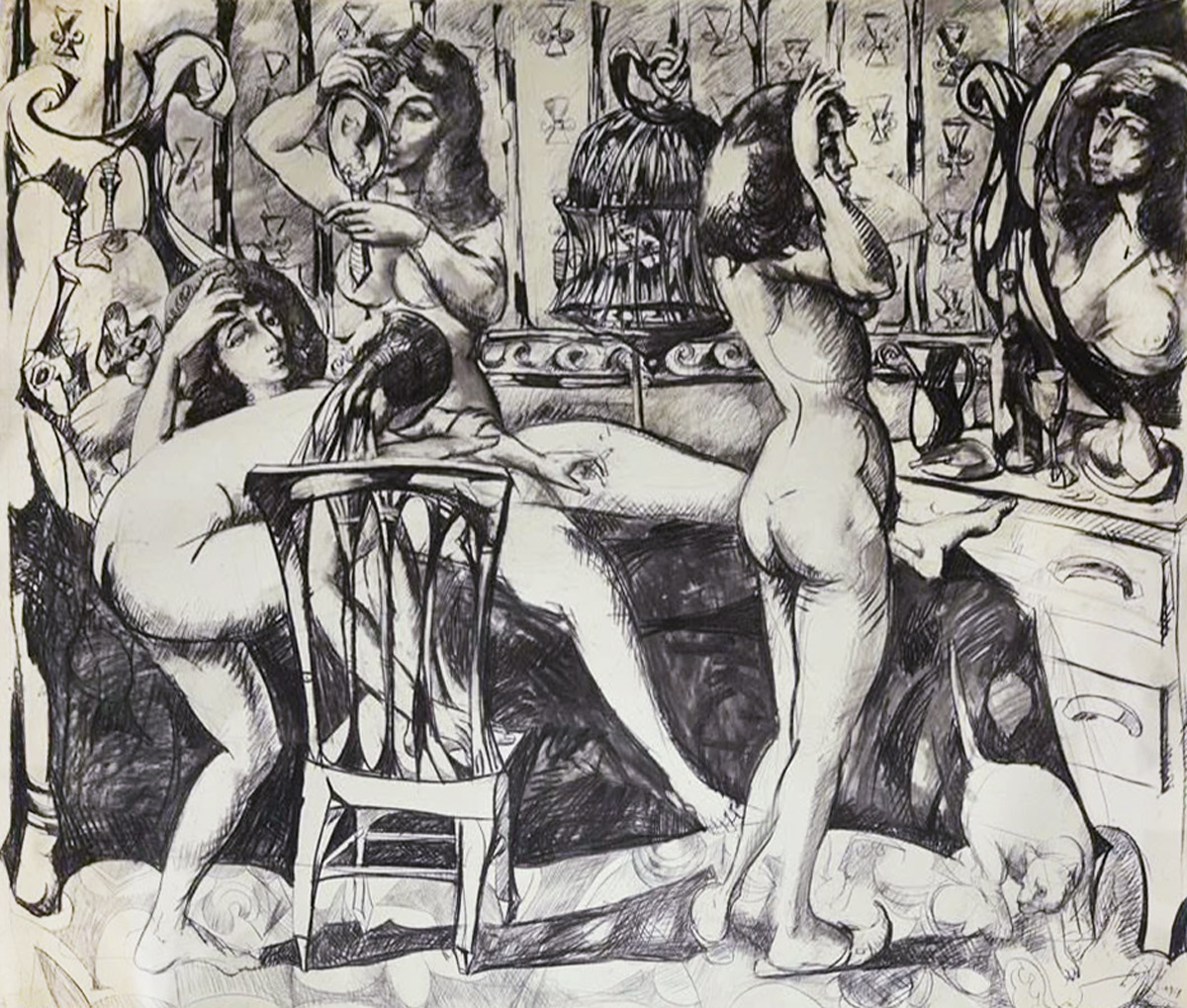Sale 2614 - Lot 232
Unsold
Estimate: $ 5,000 - $ 8,000
LEON KELLY
Damas en Budoar.
Conté crayon on heavy wove paper, 1958. 1580x2035 mm; 62x80 inches. Signed and dated in crayon, lower right recto, and titled in crayon, left edge recto; and counter signed, titled and dated in ink, verso.
Provenance: Julien Levy, New York and New Haven; Jean Farley Levy, Julien Levy's widow, Connecticut; The Jean and Julien Levy Foundation for the Arts, Newtown, Connecticut; private collection, Chicago.
Kelly (1901-1982) was born in Philadelphia and studied at the School of Industrial Art (now the University of the Arts), Philadelphia, and with Arthur Beecher Carles (1882-1952) at the Pennsylvania Academy of Fine Arts, Philadelphia. He was an avid student and also sought out instruction outside of formal art school. He was granted permission to study anatomy at the Philadelphia School of Osteopathy where he dissected a cadaver and perfected his knowledge of the human figure. He also met and studied etching with the Philadelphia printmaker Earl Horter (1881-1940). During the mid-1920s, Kelly traveled to Paris and became acquaintances with Henry Miller, James Joyce and the critic Félix Fénéon as well as copying frequently at the Louvre. He is most well-known for his contributions to American Surrealism, but his work also encompassed styles such as Cubism, Social Realism and Abstraction. Reclusive by nature, a character trait that became more exaggerated in the 1940s and later, Kelly's work reflects his determination not to be limited by the trends of his time.
Kelly married Helen Horter, the ex-wife of his mentor Earl Horter, in 1941, his second marriage after a brief marriage with a French woman, Henriette D'Erfurth, during the 1930s had dissolved. In 1940, Helen Horter had contacted Julien Levy, a Harvard classmate of her brother-in-law Paul Vanderbilt, to propose an exhibition of drawings by Kelly. Levy's gallery, The Julien Levy Gallery on 57th Street in New York was at the forefront of innovation and Surrealism. His stable included Salvador Dalí, Arshile Gorky, Yves Tanguy, Roberto Matta, Max Ernst, Joseph Cornell and Marcel Duchamp. Levy was impressed by Kelly's work and began representing him. His first show was an exhibition that traveled to the Art Alliance in Philadelphia in 1941. A one-man show followed in March 1942 in New York. In 1943, the magazine View printed nudes by Kelly and Pablo Picasso that resulted in the banning the issue in the United States. In 1944, Kelly had a second one-man show at the Julien Levy Gallery.
Damas en Budoar.
Conté crayon on heavy wove paper, 1958. 1580x2035 mm; 62x80 inches. Signed and dated in crayon, lower right recto, and titled in crayon, left edge recto; and counter signed, titled and dated in ink, verso.
Provenance: Julien Levy, New York and New Haven; Jean Farley Levy, Julien Levy's widow, Connecticut; The Jean and Julien Levy Foundation for the Arts, Newtown, Connecticut; private collection, Chicago.
Kelly (1901-1982) was born in Philadelphia and studied at the School of Industrial Art (now the University of the Arts), Philadelphia, and with Arthur Beecher Carles (1882-1952) at the Pennsylvania Academy of Fine Arts, Philadelphia. He was an avid student and also sought out instruction outside of formal art school. He was granted permission to study anatomy at the Philadelphia School of Osteopathy where he dissected a cadaver and perfected his knowledge of the human figure. He also met and studied etching with the Philadelphia printmaker Earl Horter (1881-1940). During the mid-1920s, Kelly traveled to Paris and became acquaintances with Henry Miller, James Joyce and the critic Félix Fénéon as well as copying frequently at the Louvre. He is most well-known for his contributions to American Surrealism, but his work also encompassed styles such as Cubism, Social Realism and Abstraction. Reclusive by nature, a character trait that became more exaggerated in the 1940s and later, Kelly's work reflects his determination not to be limited by the trends of his time.
Kelly married Helen Horter, the ex-wife of his mentor Earl Horter, in 1941, his second marriage after a brief marriage with a French woman, Henriette D'Erfurth, during the 1930s had dissolved. In 1940, Helen Horter had contacted Julien Levy, a Harvard classmate of her brother-in-law Paul Vanderbilt, to propose an exhibition of drawings by Kelly. Levy's gallery, The Julien Levy Gallery on 57th Street in New York was at the forefront of innovation and Surrealism. His stable included Salvador Dalí, Arshile Gorky, Yves Tanguy, Roberto Matta, Max Ernst, Joseph Cornell and Marcel Duchamp. Levy was impressed by Kelly's work and began representing him. His first show was an exhibition that traveled to the Art Alliance in Philadelphia in 1941. A one-man show followed in March 1942 in New York. In 1943, the magazine View printed nudes by Kelly and Pablo Picasso that resulted in the banning the issue in the United States. In 1944, Kelly had a second one-man show at the Julien Levy Gallery.

Exhibition Hours
Exhibition Hours
Aliquam vulputate ornare congue. Vestibulum maximus, libero in placerat faucibus, risus nisl molestie massa, ut maximus metus lectus vel lorem.


